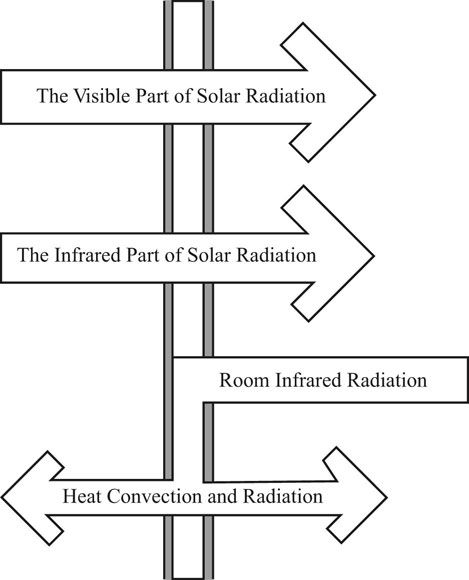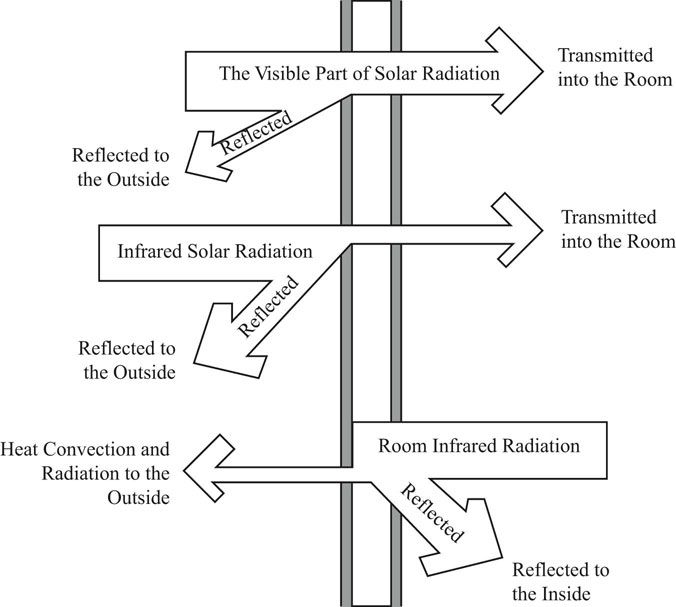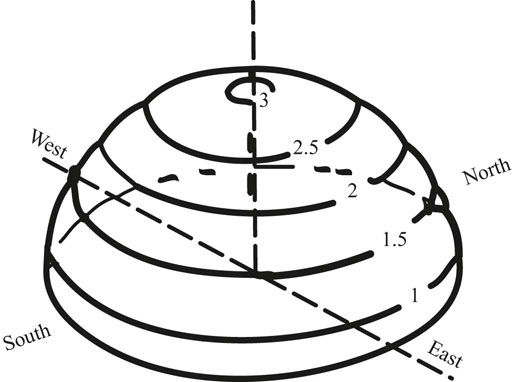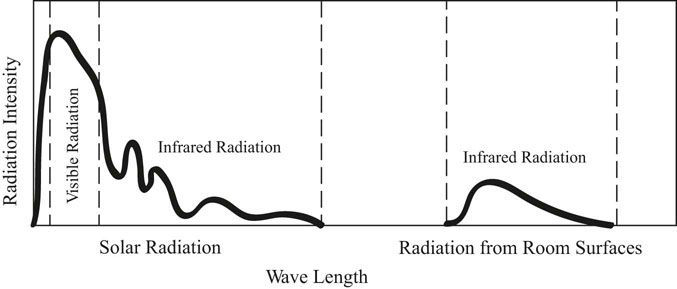Daylighting design starts with an understanding of the sky. An overcast sky has a luminance that is 3 times brighter at the zenith than at the horizon (Figure 21.1). An overcast sky is also equally bright in all directions. This equal brightness feature is the result of water vapor scattering all wavelengths of light all over the sky. Because all wavelengths are scattered the sky appears white. A clear sky is 10 times brighter in the area around the Sun than it is in an area of the sky that is opposite the sun in the sky (Figure 21.2). The clear sky is blue because the nitrogen, oxygen, and carbon dioxide molecules that make up our atmosphere scatter the higher energy blue wavelengths leaving the rest of the spectrum to penetrate through without any scattering (Moore 1985, 30–32).
Our eyes evolved under daylight, so it is not a surprise that daylight provides high efficacies. The efficacy of the Sun and sky is 100–150 lumens/watt. Incandescent light is 20–40 lumens/watt. Fluorescent light is 50–80 lumens/watt (Moore 1985, 30). Daylight has a high amount of visible light in relation to the total amount of thermal heat involved.
The solar spectrum starting from the high energy side has an ultraviolet part, a visible part, and an infrared part (Figure 21.3). Our eyes are designed to see the visible part from blue through green, yellow, and red. When all of these wavelengths are combined together as they are in daylight our eyes perceive this as white light. The ultraviolet part of the spectrum has high energy and causes materials to fade. The infrared part of the spectrum is felt as thermal heat.
Clear glass allows the entire solar spectrum through the glass. This energy hits interior surfaces and furniture, heating them up. These interior surfaces then reradiate infrared energy at a much lower energy level than the solar spectrum. Regular clear glass is opaque to this room infrared radiation. The result is that the room infrared is absorbed by the glass as if the glass were a black wall. Some of the energy returns to the room, and some of the energy goes back outside. Double glazing reduces this heat loss to the outside (Figure 21.4).
FIGURE 21.1 An overcast sky is three times as bright overhead compared to the horizon and is equally bright in all directions because clouds scatter all the frequencies of light around the sky.
Source: Moore 1985.

FIGURE 21.2 A clear sky is ten times as bright near the Sun compared to locations on the other side of the sky from the Sun. The sky is blue because air molecules scatter only the blue light.
Source: Moore 1985.
FIGURE 21.3 The solar energy spectrum compared to the infrared radiation emitted from warm room surfaces.
Source: Moore 1985.

FIGURE 21.4 Radiation transfer through clear double glass.
Source: Moore 1985.
For passive solar heating in residential buildings, the selective coating that lets in the entire solar spectrum and then is reflective to the room infrared is ideal because a maximum amount of solar gain is admitted while minimizing heat loss through the window from the interior (Figure 21.5). For daylighting in commercial buildings, heating is less of an issue. The primary concern is providing lighting. The selective surface that reflects both the infrared part of the solar spectrum and the infrared room radiation allows the visible part of the solar spectrum to penetrate through the glass while reflecting the infrared part of the solar spectrum away from the building (Figure 21.6). It also reflects room infrared back into the room, which reduces the heat loss through the glass.

FIGURE 21.5 Radiation transfer through low-e double glass designed to maximize solar heat gain through the glass and minimize heat loss back out the glass.
Source: Moore 1985.

FIGURE 21.6 Radiation transfer through low-e double glass designed to maximize daylight penetration and limit solar thermal radiation transfer.
Source: Moore 1985.

